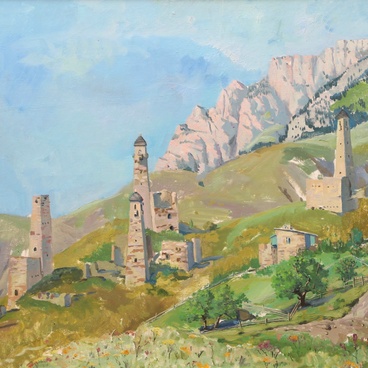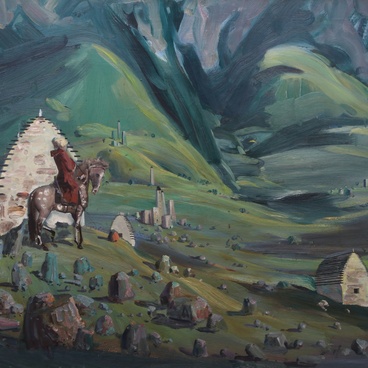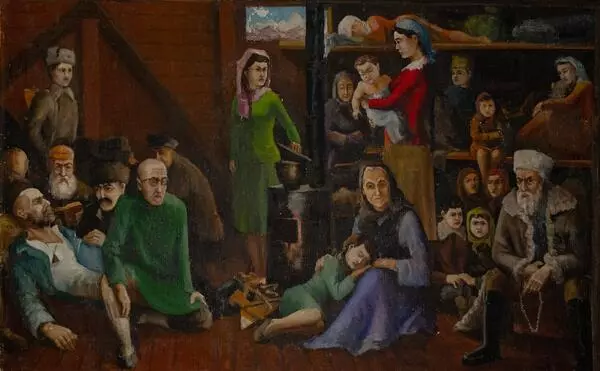Bashir Daurbekov dedicated the painting ‘Autumn. Sunset’ to his native land. He captured the surroundings of his ancestral village of Barsuki in the Nazranovsky District: golden fall leaves and a swift stream. The landscape shines with the soft rays of the evening sun. The master worked with noticeable frequent brush strokes: the grass and trees seem vague as if the light slightly blinds the eyes and does not allow to see the landscape in detail.
The artist created the painting by contrasting oranges and blues. These colors are called complementary colors. On the color wheel, they are located opposite each other and when mixed have a neutralizing effect and give a grayish color. At the same time, due to this contrast, they noticeably complement each other in the paintings: if placed side by side they seem especially vivid. Bashir Daurbekov took advantage of this knowledge and was able, by contrasting oranges and blues, to create a joyful landscape: the fiery leaves are framed by the blue sky and the blue waters of the stream glow especially brightly.
Bashir Daurbekov is a famous Ingush artist, a member of the Artists’ Union of Russia and the Artists’ Union of the Republic of Ingushetia. He was born on May 27, 1954, in the village of Fedorovka in the Kostanay Region of the Kazakh Soviet Socialist Republic, and in 1988, he graduated from the Krasnodar Art School. Presently, he teaches at a children’s art school in the city of Nazran and has already taught several generations of talented youth.
He is mostly known as a master of mountain landscapes: many of his paintings depict the landscapes of Ingushetia with great views and ancient towers. The master does not have a uniform style: some of his painting are intense and fierce, others are light and lyrical. They are united by the ease of execution and close attention to nature, a desire to display the nuances of lighting at a particular time of the year and day.
Bashir Daurbekov paints with frequent, clearly visible colorful brush strokes thus trying to convey the play of light and shadow on water and leaves. This approach helps to convey a fresh impression of a moment in time and space. But at the same time, the artist never focuses only on the external: his paintings are distinguished by a poetic generalization, each of them is about a person’s love for the nature of their homeland.
The artist created the painting by contrasting oranges and blues. These colors are called complementary colors. On the color wheel, they are located opposite each other and when mixed have a neutralizing effect and give a grayish color. At the same time, due to this contrast, they noticeably complement each other in the paintings: if placed side by side they seem especially vivid. Bashir Daurbekov took advantage of this knowledge and was able, by contrasting oranges and blues, to create a joyful landscape: the fiery leaves are framed by the blue sky and the blue waters of the stream glow especially brightly.
Bashir Daurbekov is a famous Ingush artist, a member of the Artists’ Union of Russia and the Artists’ Union of the Republic of Ingushetia. He was born on May 27, 1954, in the village of Fedorovka in the Kostanay Region of the Kazakh Soviet Socialist Republic, and in 1988, he graduated from the Krasnodar Art School. Presently, he teaches at a children’s art school in the city of Nazran and has already taught several generations of talented youth.
He is mostly known as a master of mountain landscapes: many of his paintings depict the landscapes of Ingushetia with great views and ancient towers. The master does not have a uniform style: some of his painting are intense and fierce, others are light and lyrical. They are united by the ease of execution and close attention to nature, a desire to display the nuances of lighting at a particular time of the year and day.
Bashir Daurbekov paints with frequent, clearly visible colorful brush strokes thus trying to convey the play of light and shadow on water and leaves. This approach helps to convey a fresh impression of a moment in time and space. But at the same time, the artist never focuses only on the external: his paintings are distinguished by a poetic generalization, each of them is about a person’s love for the nature of their homeland.





